Read also:
- Ultimate Korea Travel Guide!
- The Best Men’s Korean Fashion Online Shopping Stores & Trends 2022
- Online Shopping in Korea
- Beautiful Places to Visit near Seoul – Nami Island
Traditional Korean Floor Heating System – Ondol
An underfloor heating system heats Korean houses because most Koreans live on the room floor without tables and chairs. This type of heating system is quite common in Korea, and it’s called ondol, 온돌. When you light a fire in the furnace called Agungi (아궁이) in the kitchen with wood, the hot steam heats the floor of the room next to it. Housewives used Aguni to cook food as well.
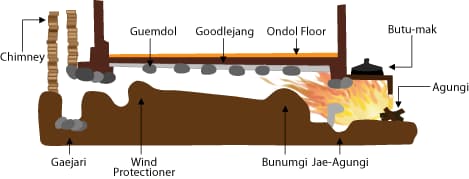
Check Out the Best Korea Tours!
Recent Korean Floor Heating System
Koreans developed and improved the Ondol system to the current Korean floor heating system (Koreans commonly call it Boiler). The system uses city gas (LNG) or oil as fuel rather than wood and is also used to heat the house and provide hot water to the kitchen and bathroom. Usually, normal houses in town use the city gas.
Many visitors to Korea make the mistake of turning on the air-conditioner when they arrive at the house to warm up. But in Korea, generally, an air-conditioner in the apartment is only used for cooling during the summer which means it has no heating function. Therefore, please don’t turn on the air-conditioner in the winter season.
The Basic Structure of the Recent Korean Floor Heating System
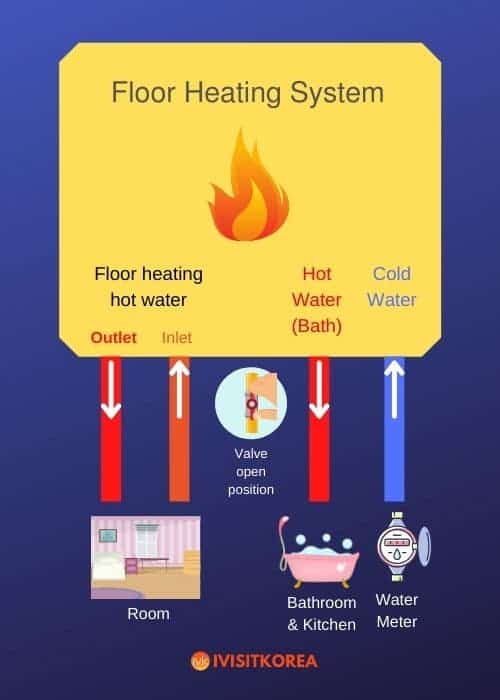
There are four main pipes under the body of the floor heating system. Left two pipes and valves are used to heat the floor of the house. Coldwater from outside through the water meter is supplied to the system through the rightmost pipe, and hot water for the bathroom and kitchen comes out through the second pipe from the right side.
As you see in the upper image, it uses hot water to heat the floor. And it is possible because the pipes that hot water travels are installed under the floor. I didn’t describe it, but there is also a gas pipe (usually yellow).
Seasonal Picks by IVisitKorea!
How To Detect Faults & Causes in Underfloor Heating
- Most of all, if there’s any issues with the heating or hot water (Basic checklist).
- Check the wall controller settings and if it has an error code
- If there’s an error code, find the code in the system manual
- Check the power plug of the main heating system body is plugged well
- Check the gas and distributor valves are open
- I only have cold water, not hot water.
- After the basic checks,
- Check the cold water valve is open (see the upper image)
- If it’s cold outside, the water inlet could be frozen (See how to thaw pipes below)
- Remove insulation materials and thaw two pipes, hot water, and cold water pipes on the right side, together with a dryer or heater
- You can wrap two pipes with towels and pour warm water (Under 60 degrees celsius)
- I don’t have both hot and cold water.
- After the basic checks,
- Check if there is any water supply issue in your neighborhood.
- If it’s not the water shortage problem and cold outside, the water supply pipe can likely be frozen. The area near the water meter is most likely to freeze because it’s exposed to the outside. Contact a nearby plumber.
How To Prevent Pipes from Freezing
Prevention is better than cure as always. To prevent frozen pipes;
- Don’t turn off the heating system when you go outside (Set it to “Leave” at least)
- Keep the main body’s pipes insulated by the right-size pipe insulation foam
- Open the hot water faucet slightly and run water during nighttime or when you are outside
How To Cut Down Gas Bill
If you don’t have any experience using a gas boiler in Korea, you can be surprised when you receive a bill. It’s difficult to tell how much will be billed because there are many factors to determine the gas cost of a boiler. It depends on a variety of reasons, such as the number and size of the rooms, the outside temperature, the set room temperature, how much hot water you use, whether you use a gas stove, etc.
However, there are common tips to cut down the gas bill, so let’s take a look.
- Set ‘Leave (외출)’ mode when you are outside. Don’t turn off the boiler because it consumes the most gas when the temperature is raised rapidly.
- Insulate windows with bubble wrap and use a weatherstrip at the door
- Try to reduce the use of hot water
- After using the faucet, turn the handle to the cold-water side.
- You can consider using an electric mat or heater. Electric heaters and humidifiers help to circulate indoor air to maintain indoor temperature.
- If you are using a gas stove, it is helpful to save on gas costs by using a medium fire rather than a strong one.
How To Use Korean Floor Heating & Hot Water System
When you stay in a Korean house, you may find a little controller(thermostat) on the wall. You could get hot water or floor heating(or both) by turning it on. The problem is there are dozens of temperature controller manufacturers in Korea, and all controllers are written in Korean. It might be so confusing as foreigners can’t speak or read Korean. I hope this post can help you keep warm during your stay in Korea.
Please, check the manufacturer’s name first and click the proper links below. Even if the controller is not the same as the one in your house, it will work similarly. Let me show you how to use the Korean floor heating and hot water system.
Rinnai Boiler (린나이 보일러)
Indoor Thermostat Type 1. RBMC-43
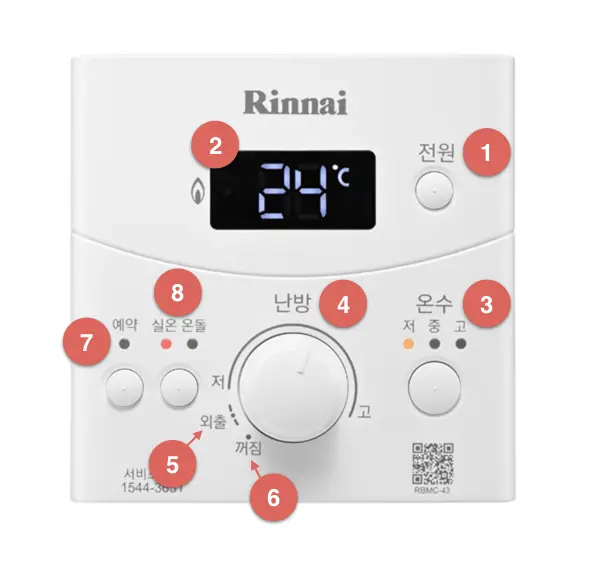
- Power (전원): Turn On/Off (Reset)
- Display: Temperature
- Hot water (온수): Select to provide a large amount of hot water for bath and shower. Temperature: Low (저) Mid (중) High (고)
- Heating (난방): Heating temperature wheel. Low (저) / High (고)
- Leave Function (외출): To make the heating system to a low temperature.
- Heating Off (꺼짐): To turn off the heating (usually in the summer we use this).
- Schedule (예약): Schedules the time to start and stop the boiler.
- Room temperature-heating (실온) / Floor-heating (온돌): Choose which one you want to set.
Indoor Thermostat Type 2. RBMC-56
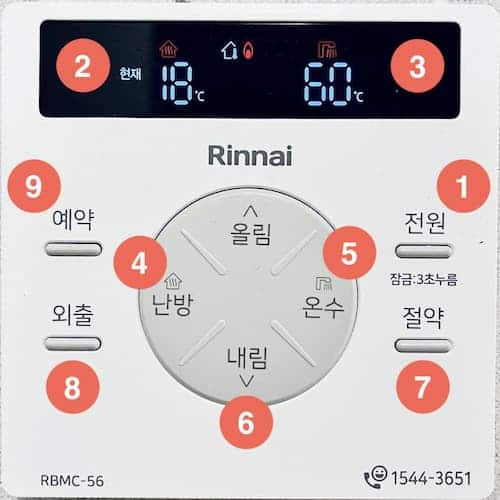
- Power(전원): Turn on/off.
- Current floor heating temperature (현재).
- Water temperature for the shower. (Normally, it is set to 45)
- Floor Heating (난방): Turn on/off.
- Hot water (온수): Turn on/off.
- Up/Down (올림/내림): Increases or decreases the target value of a specific function(Floor heating/ Water).
- Save mode (절약): To cut down the gas bill, it set the max temperature of floor heating to 25. (It doesn’t go up automatically)
- Leave Function (외출): To make the heating system to a low temperature.
- Schedule (예약): Schedules the time to start and stop the boiler.
Indoor Thermostat Type 3. RBMC-12
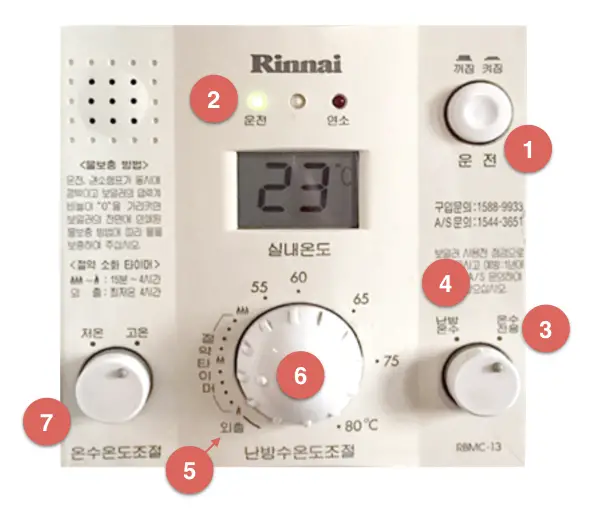
- Power(전원): Turn On/Off (Reset)
- LED Operation Indicator (운전): Turns on while the boiler is operating.
- Only Hot water (온수전용): Select to provide hot water only (no floor heating / usually used in the summer).
- Hot water & Floor Heating (난방온수): Select to provide both hot water and floor heating (in winter).
- Leave Function (외출): To make the heating system to a low temperature.
- Heating (난방수온도조절): Floor heating temperature wheel.
- Water temperature (온수온도조절): Low (저온) High (고온).
Indoor Thermostat Type 4. RBMC-28
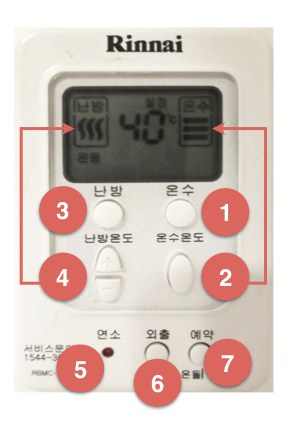
- Hot water (온수): Select to provide hot water (in summer and winter).
- Water temperature (온수온도): Low – Mid – High
- Floor Heating (난방): Floor heating is operated (only in winter).
- Floor heating temperature (난방온도): Low (저온) High (고온).
- LED Operation Indicator (연소): The boiler burner is ON.
- Leave Function (외출): To make the heating system to a low temperature.
- Schedule (예약): Schedules the time to start and stop the boiler.
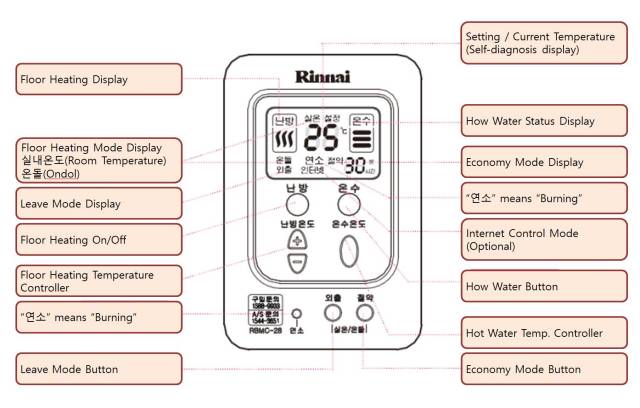
Kiturami Boiler (귀뚜라미 보일러)
Indoor Thermostat (CTR-5700)
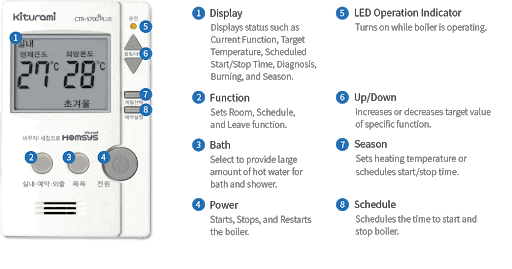
1. Display: Displays status such as Current Function (현재온도), Target Temperature (희망온도), Scheduled Start/Stop Time (예약), Burning (운전), and Season (계절).
2. Function: Sets Room (실내), Schedule (예약), and Leave function (외출). > To operate floor heating make a status on 실내(Set Room temperature) mode.
3. Bath (목욕): Select to provide a large amount of hot water for the bath and shower.
4. Power (전원): Turn On/Off (Reset)
5. LED Operation Indicator: Turns on while the boiler is operating.
6. Up/Down (올림/내림): Increases or decreases the target value of a specific function.
7. Season (계절선택): Sets heating temperature (Spring:봄, Summer:여름, Autumn:가을, Beginning of Winter:초겨울, Winter: 겨울) or schedules start/stop time.
8. Schedule (예약설정): Schedules the time to start and stop the boiler.
Indoor Thermostat (CTR-8000)
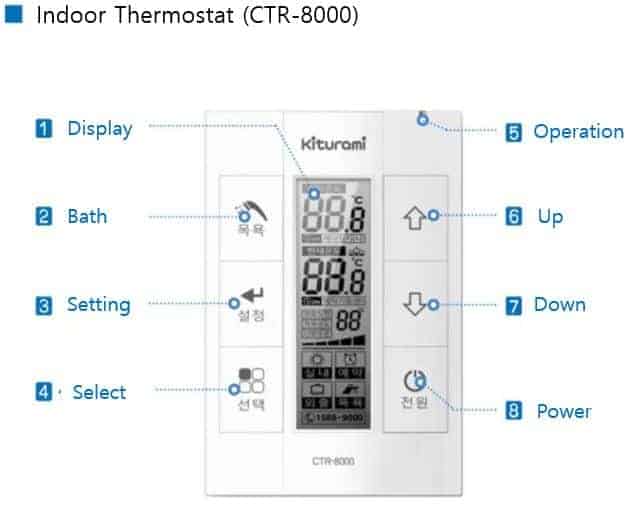
1. Display: Displays status such as Current Function (현재온도), Target Temperature (희망온도), Scheduled Start/Stop Time (예약), Burning (운전), and Season (계절).
2. Bath (목욕): Select to provide a large amount of hot water for the bath and shower.
3. Setting (설정): To configure the floor heating and hot water temperatures
4. Select (선택): Select the setting menu
5. LED Operation Indicator: Turns on while the boiler is operating.
6-7. Up/Down (올림/내림): Increases or decreases the target value or the temperature
8. Power (전원): Turn On/Off (Reset)
To use indoor heating
1. Click 4. 선택 (Select)
2. Choose the setting mode you want to change. When you click “선택 (Select), the setting mode changes, 실내 (Indoor) – 예약 (Reservation) – 외출 (Leave), one by one.
3. If you selected the setting mode, change the target temperature (희망온도) using the Up / Down buttons.
4. Click 4. 선택 (Select) or it will be applied if you just leave it.
To use hot water
1. Click 3. 설정 (Setting). Then the hot water display bar starts to flash.
2. Set the target hot water temperature using Up / Down buttons.
3. Click 4. 선택 (Select) or it will be applied if you just leave it.
Navien Boiler (나비엔 보일러)
Indoor Thermostat Type 1. NR-40S
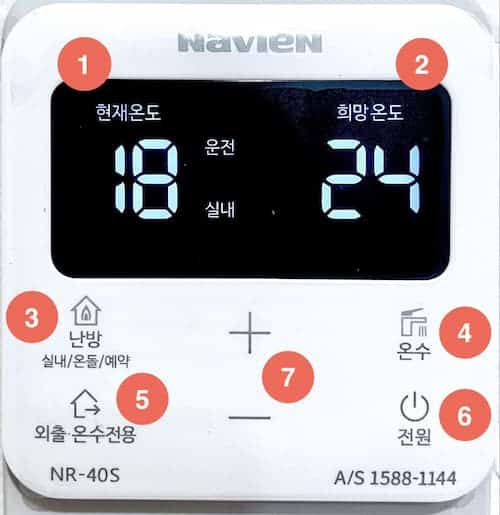
- The current temperature of floor heating (현재온도) / LED Operation Indicator(운전): Turns on while the boiler is operating.
- Target temperature (희망온도).
- Floor-heating(난방): Activate floor-heating (in Winter).
- Hot water (온수).
- Leave Function(외출)/Only hot water: Select to make the heating system to a low temperature but hot water working (in Summer).
- Power(전원): Turn On/Off.
- Up/Down: Increases or decreases the target value or the temperature
Indoor Thermostat Type 2. NR-10E
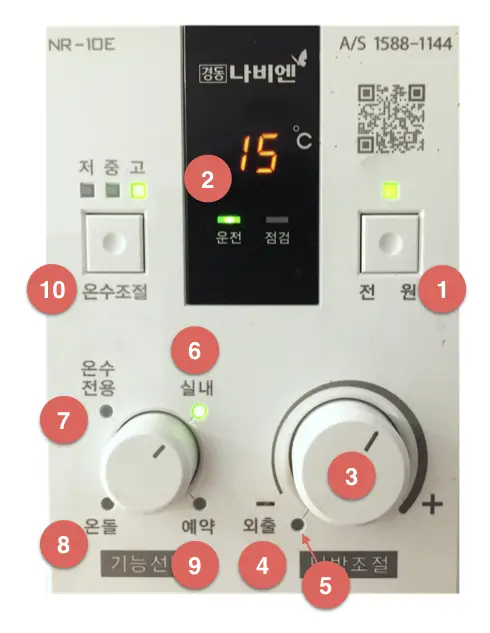
- Power(전원): Turn On/Off (Reset)
- LED Operation Indicator(운전): Turns on while the boiler is operating.
- Floor Heating Temperature Wheel(난방조절): Floor heating operated / Low(-) High(+).
- Leave Function(외출): Select to make the heating system to a low temperature.
- Heating Off(꺼짐): Select to turn off the heating (usually, we use this in the summer).
- Room temperature heating (실내): Activate room temperature heating (in winter).
- Only Hot water(온수전용): Select to provide hot water only (No floor heating/used in summer).
- Floor-heating(온돌): Activate floor-heating (in winter/similar function with 실내).
- Schedule(예약): Schedules the time to start and stop the boiler.
- Water temperature(온수조절): Low(저) Mid(중) High(고).
Indoor Thermostat Type 3. FR-5
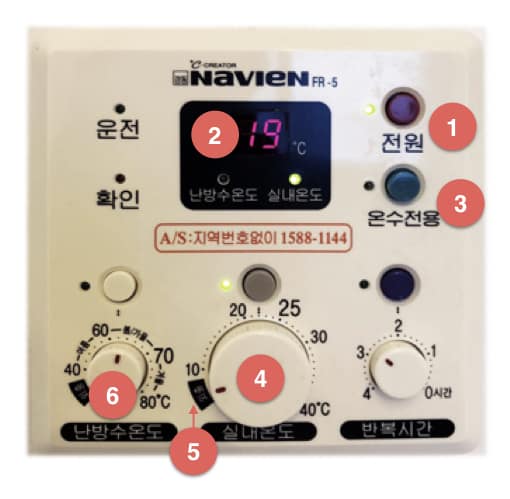
- Power(전원): Turn On/Off (Reset)
- Display: Displays status such as Room-temperature(실내온도), Water Temperature(난방수온도), Burning(운전).
- Only Hot water(온수전용): Select to provide hot water only (no floor heating/in summer).
- Floor Heating Temperature Wheel(실내조절): From 10 to 40 degrees.
- Leave Function(외출): Select to make the heating system to a low temperature.
- Water temperature(난방수온도): Summer(여름 ), Spring/Autumn(봄/가을), Winter(겨울).
These control box samples will help you turn on the heated floor and hot water while you are experiencing the freezing cold weather in South Korea. Let us know if you run into any problems. While you are experiencing the different types of heating systems in Korea, also check out “Things to do in Korea in Winter,” to plan out your winter trip. Korea is surrounded by mountains, so it’s the perfect place to go skiing and snowboarding. Here are the Best Ski Resorts in Korea. If you do not have time to go skiing, check out the winter festivals in Korea as well. It is the perfect place to experience the holidays in another country.
Let us know if you have any questions. We are here to help!


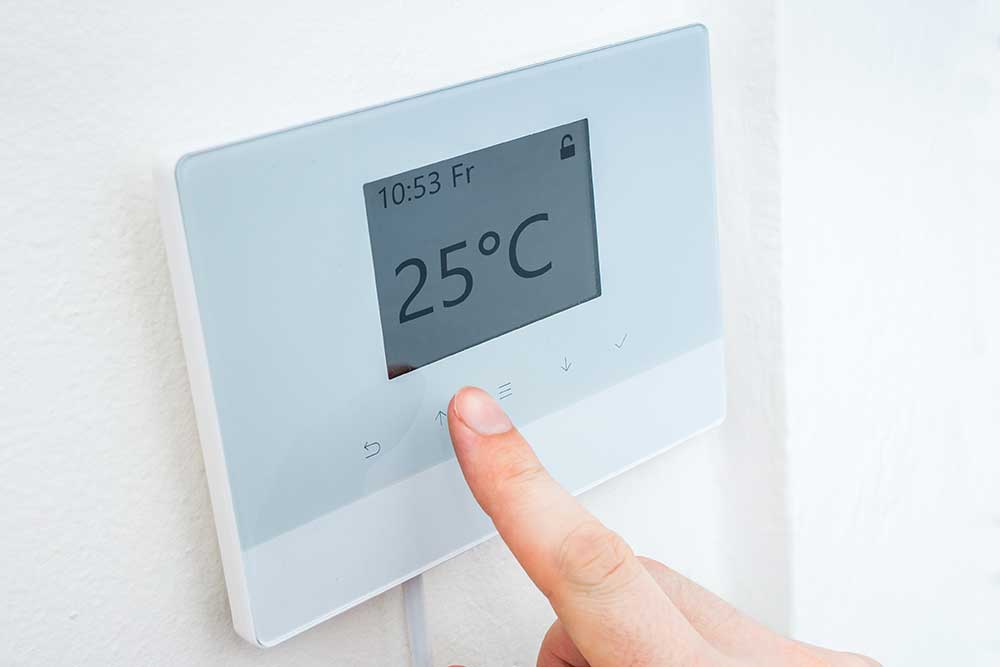




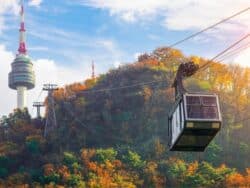



Hi, thanks for this post.
I have a Rinnai Indoor Thermostat Type 2 (same as you have shown here). For the two months before December came along, when I was only using hot water 온수전용 for showering with with ‘water temperature’ (온수온도조절) knob to low(저온), I got my gas bills around 3000 won, but this last month when I turned on the room+water (난방온수) knob, along with turning the ‘water temperature’ (온수온도조절) knob to High(고온), my gas bill escalated to a surprising 34000 won! I used the room heating for around 7 hours every night on this setting for a month. Is it because I turned the 온수온도조절 to 고온? Please guide me how I can have a setting that wouldn’t have me incur such high bills?
Hi Hiba,
The main reason for the increased bill is because you started floor heating.
Even I don’t know the size of your heating system and your house, 34,000 KRW a month is not a high bill.
Please, check the monthly house heating fee of your friends and neighbors.
Kind regards,
Dy & Jay
Glad to be one of many visitors on this awesome
site :D.
Здравствуйте у меня rbmc 28 .я не могу горячую воду включить .хотя прочитала как вы написали.помогите пожалуйста 😔
Hi Wake,
Thank you for reaching out. Hot water works in two ways.
– Only Hot water(온수전용): Select to provide hot water only (no floor heating /used usually in the summer)
In this case, just push the “온수 (Hot water)” button.
– Hot water & Floor Heating(난방+온수): for both hot water and floor heating
In this case, push “난방 (Floor heating)” and “온수 (How water)” as well.
If the hot water is turned on, you can see the hamburger icon with “온수” at the top right corner of the controller screen.
I’ll add RBMC-28 model to the post today.
Best regards,
Jay & DY
This is a really great content, I can see how detailed you have gone through and explained about how to use Korean floor heating system. I love this article, thanks for producing such great contents. I love your posts always.
Hi. Just wanna ask how to set my kiturami ctr-5700 plus boiler when leaving my house to avoid the pipes being frozen during winter season? And what is the ideal winter degree temperature enable to activate this?
Hi Leonardo,
Thank you for reaching out. When you set the controller to “외출(Leave)”, it maintains the temperature to 8 degrees Celsius to avoid pipe freezing.
But when you come back home, you might feel cold and it will take some time to heat up. I only use “외출(Leave)” feature, when I leave the house for a couple of days.
I hope it can be an answer to your question.
Warm regards,
Jay
Hi. Asking for some help due to my kiturami ctr 5700 plus has no power by now as in literally no display . But before the power totally gone i ‘ve used it …like there is a strange noise from the pipe everytime i used to and open the water… I am badly needing hot water especially now …winter is coming …Please ..please needing your assistance. Looking forward hearing from you .
Thank you very much ..Be Blessed…
Hi Jha,
Even I’m not a floor heating system engineer, I searched for the answer to your problem because I thought there might be more information in Korea than yours.
This is the best post in Korean I found. Please, use the Google Translation to read it and let me know if you need any more help.
https://blog.naver.com/janocan/221703888001
Hope you fix the problem soon.
Best regards,
Jay
I have one general question. Is there a need to keep the boiler ON for both water heating and floor heating throughout the day during winters ?
Yes, usually the boiler is needed to turn on for hot water and floor heating. 🙂
Hi, I recently moved into a small one-room and am not used to the heating system. Do I need to have the heating on at all times to prevent the pipes from freezing? Will I be charged as much as normal heating if I put it on 외출? I was aware that the heating cost is high so I have not been using the heater much. Thank you so much for your blog it is really informative.
Hi Hanamam,
Thank you for reading our blog post.
When you leave the house for over several hours, make it to “Leave (외출)”.
Leave feature avoids pipe freezing and you can heat up the room temperature quickly when you get back home.
I hope it helps you to stay warm.
Kind regards,
Jay
I have Navien FR-5 heating system. It takes more time to heat up. Like 3/4 hours to go temperature from 17 to 19. How can I reduce the heating time? And if I keep power button turn on and select leave option, is not that increase gas bill?
Hi Rakhi,
If it takes 3 to 4 hours to heat up the room temperature from 17 to 19, I recommend you to get an inspection from a plumber. It’s not a normal condition.
And about the appropriate temperatures when you sleep or away from home, please take a look at the article from the Department of Energy. https://www.energy.gov/energysaver/thermostats
Best regards,
Jay
Please help. Im cold… haha. I left my shower on all night with heat on. And today my shower is working just fine by my floor heating, which was on too, isnt. It makes a grinding sound and turns off. I turned my shower back on and that is working but floor isnt
Hi Megan,
There could be many reasons. Are all rooms cold? Do you think it’s not working at all or works but it’s not hot like before?
If it’s very cold outside, the circulation pipe might be frozen. If there’s no heat on the floor at all, you may have to check the three-way valve with an engineer. If you think there’s heat but it’s not warm as before, you may have to drain air from the pipes.
Please, check it with a nearby engineer. Happy New Year and hope it works again.
Best regards,
Jay
Xin chào. Tại sao máy nước nóng của tôi bật lên không có nước nóng, xong còn trở về chế độ 확인 và 0,3 và nước không nóng.
Hi Tien,
I’m sorry I can’t speak Vietnamese.
This is the Google translation of your words and it’s hard to understand the situation.
If you let me know the controller’s model number, I will try to find the manual.
Best,
Jay
Tiến ơi. Sửa dc chưa. Tôi cũng bị lỗi giống bạn. Hãy chỉ tôi cách sửa nhé
I had a question about your experience with humidity and floor heating. Someone posted some advice about using floor heating in conjunction with the AC to lower the humidity in the house. What is your take on that? To me it sounds like you are just wasting energy and that by using the floor heat it will only add to the humidity not lessen it. Thoughts?
Hi Candace,
Thank you for reading the article and reaching out to us. First, I should make it clear that I’m not a professional heating system engineer.
We just wanted to help visitors to Korea can use the Korean floor heating system well as we have used Korean floor heating systems for a long time.
Personally, I agree with your opinion that turning on the AC and floor heating system at the same time is a waste of energy.
AC itself dehumidifies and there is a dehumidification mode as well.
Thanks again.
Jay
Hello, I am looking for the Lotte Hi-Q 16 bit manuals in english. Any pointers?
Hello Henrique,
Unfortunately, I could only find the Korean version manual.
I will send ST and DX-type Korean manuals to your email address.
Sorry but that’s the best at the moment.
Best,
Jay
Hi Jay,
Thank for your helpful and super informative article!
My just-moving-in 18sqm one room (include the small kitchen area, bathroom, the bedroom, and the veranda) is equipped with the Indoor Thermostat Type 2.
The problem is I set the maximum water temperature at 80 Celcius degree for all night, but the 실내온도 keeps going around 20-21 degree in this winter. The floor is warm but the room temperature could not exceed 21. Plus, I keep closing all the windows and doors for most of the time for avoiding waste of heating temperature. I think it’s not a normal situation.
I contacted the facility manager of the building, he explained that because my room has been empty for long time (maybe around 1 month) so the heating system is not working efficiently and he suggest I should turning it on all the time for the next 2-3 days. I think it does not make any sense.
I’m afraid that the gas bill would be high and inefficient if I keep setting it at the maximum temperature all night, but the room does not exceed 21-22 degree.
What should I do in this situation?
Best regards,
Huy
Hello Huy,
Thank you for reading the article and reaching out to us.
When the room temperature doesn’t go up, there could be a couple of reasons, such as stuck pipe or hot water only mode. But you said that the floor is warm, so I recommend you wait and see for a couple of days. If you keep heating water temperature to 60-70 degrees, the heating cost is expected to be about 100,000 to 150,000 won per month. Don’t turn off heating while you are outside or when you sleep. Doing so will consume more gas to rapidly increase the temperature. Increasing the temperature little by little saves gas, and once the temperature rises, less gas is consumed to maintain it. If the problem continues after a couple of days, you may have to call a boiler guy.
Jay
xin chào! Sưởi nền của tôi là loại kiturami 5700. Đã 2 ngày nay tôi bật nên thì nó nháy đèn tín hiệu và không hoạt động.tôi đã setting nhiều lần nhưng không có gì thay đổi. vào mùa đông thì rất lạnh và tôi thật sự cần sự giúp đỡ
Hello.
It’s hard to find out the reason through your comment.
Did you check the power of the main system? Can you hear the sound that it’s working? Is the gas valve open?
If the led of the controller is blinking, usually you can see the error code.
Please, read the paragraph of the article, “How To Detect Faults & Causes in Underfloor Heating.”
I hope you can fix the issue soon.
Hi, I have the opposite problem from everyone else. I have the indoor type 2 thermostat. My floors heat very well but I have no hot water. Even when I press the number 6 button and set it to the highest it goes, the screen shows the numbers going up but when I turn my water on it is lukewarm at best. Sometimes it’s not even warm but just freezing. How do I get hot water?
Hi,
I am living in a small one room. I used to leave heater on all day even if I am out. The temperature stand on 24 or 25. I received the bill and it shocked me I didn’t expect 90000 bill for gas. Is it ok or something wrong with boiler?
Hi Latif,
It’s a bit higher than the normal cost. There could be many reasons. It could be that the doors, windows, and walls of the house are not well insulated, or it could be that you use a lot of hot water.
To reduce the cost,
– Set ‘Leave (외출)’ mode when you are outside (Don’t turn off the boiler.)
– Insulate windows with bubble wrap and use a weatherstrip at the door
– If you are using a gas stove, it is helpful to save on gas costs by using a medium fire rather than a strong one.
– Try to reduce the use of hot water
– After using the faucet, turn the handle to the cold-water side.
– You can consider using an electric mat or heater.
I hope this will help you cut down on your boiler bill.
Best regards,
Jay
Hi Aleksa,
Please, make sure the water temperature knob (#7, 온수온도조절) is at the hight (고온) position.
If the hot water does not come out continuously even after doing so, it is recommended to have it checked through the boiler customer care center. A problem with the three-way valve can cause such issue.
I hope it’s fixed soon.
Hello,
I have a rannai controller but ive looked allover the internet for something that looks like it i feel like maybe the one in my house is outdated. My floor heater doesn’t work at all, i called my house owner but nothing was working yet it gets turned on well and the red blinking light too shows. I dont know what Could be the issue, any idea?
Hi Lina,
Please unplug the main system’s power cord and plug it back in. And check if it works or you can see the error code on the controller.
Contact the house owner and ask him/her to check it because the house owner is responsible for fixing the house heating system.
I hope it helps.
Hello! I have been living in a basement unit for about 6 months and have had no problems with the navien boiler and control panel but suddenly the display on the control panel is not working…it isn’t lighting up or anything when i press to turn it on there aren’t any numbers or anything in the display either… It is as if the batteries died. 😅 Are there batteries in the control panels? The boiler itself still turns on and runs when i turn on water and turn the faucet to hot…so i don’t think there is a problem with the boiler just the control panel..
Hi EmmaLee,
Sorry for the slow reply. I hope the problem is solved already.
There’s no battery in the control panel, and I guess it’s a problem with the panel itself.
It would be better to talk to the house owner, or if you own the house, call Navien customer care canter, 1588-1144.